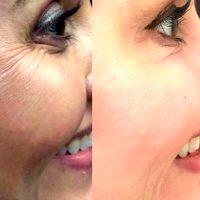Where Does Botox Work Best?
Botox is best for areas such as the forehead, glabella, and crow’s feet. In order to treat the other wrinkles around your face you may need fillers such as Restylane or Juvederm. To look your best you should consult a board certified dermatologist in your area.
The dermatologist will be able to tell you which treatments will get you the look you are trying to achieve. Botox is both safe and effective if you have a highly trained professional performing the treatment. (Adebola Dele-Michael, MD, FAAD, New York Dermatologic Surgeon)
Botox works best in the upper face, but can be used other places
In the vast majority of my patients, I treat the brows, forehead and crow’s feet/upper cheeks.
These places look great when relaxed and when properly placed, facial expression can still be maintained. I have occasionally used it in the lips in very small doses to relax vertical lip lines, but even 1 unit doses can cause trouble with puckering and may even cause an asymmetric smile.

Botox And Other Neurotoxins
Using it in the lower cheeks doesn’t greatly reduce wrinkles as these are generally deeper, static wrinkles. Thus, I don’t recommend using it in the lower face. Fillers are better suited for these areas. (Matheson A. Harris, MD, Salt Lake City Oculoplastic Surgeon)
Where Does Botox Work
Botox works for dynamic wrinkles. In other words, Botox works for wrinkles caused by muscle motion, not wrinkles associate with gravity or sagging skin or loss of soft tissue.
As a result, Botox works best for frown lines (a.k.a. glabellar furrows… the area between your eyebrows), crows’ feet (a.k.a. periorbital wrinkles), and horizontal forehead lines.
Deep lines between your cheeks and lips, fine lines around the mouth, and sagging cheeks are best managed with other techniques like soft-tissue fillers, surgery or radiofrequency devices. (Andrew Kaufman, MD, Los Angeles Dermatologic Surgeon)
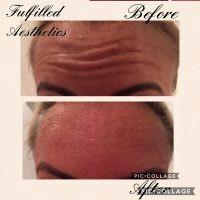
Botox Injections Can Be Used On Several Areas Of The Face And Neck With Great Results
Most effective
Botox works best in the upper face. The muscles of the brow, including those that cause the “11” and the crows feet area get the best results. Although it is occasionally used in other areas, these are the most common and most effective. (Stephan Finical, MD, Charlotte Plastic Surgeon)
Wrinkles that Botox will help
Botox treats wrinkles that are caused by repetitive muscle movements, for example the lines between the eyebrows that appear when we frown. Botox is injected into the muscle that makes the wrinkle, relaxing the muscle so it cannot make the line.
That allows the skin to smooth out and the line goes away. However, sometimes the line is so deep that it doesn’t go away right away.
It may take several months of maintaining that muscle relaxation for the skin to get smooth, or you may need to have a small amount of filler (for example, Juvederm, Restylane) injected into the line.
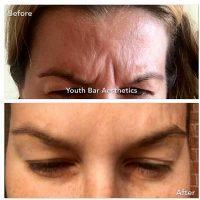
Botox Is Very Safe In The Upper Face Region
Botox only works on lines that are caused by muscle movement, so it is used primarily for the forehead, between the eyebrows, and the crows feet around the eyes. It will not work on lines and wrinkles that are caused by skin sagging or loss of volume.
That is why Botox is often used in conjunction with fillers. There isn’t only one cause of wrinkles and the appearance of aging, and there isn’t only one treatment . (Jordana S. Gilman, MD, Washington Dermatologic Surgeon)
What parts of the face is Botox best for?
Botox works well for dynamic wrinkles created by facial expression. The most common areas include the glabella which is the frown region between the eye brows, the horizontal lines in the forehead, and the crows feet at the sides of the eyes.
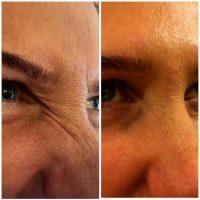
Botox To Treat Muscles Around The Nose
Less common regions include around the lips and in the neck. FDA approved Botox is generally very safe. (Todd C. Miller, MD, Newport Beach Facial Plastic Surgeon)
Botox doesn’t work for all types of wrinkles
Botox is a neurotoxin that works by relaxing the muscles of facial expression that cause the skin to fold. If your wrinkles are not caused by muscle movement, as in the case of nasolabial folds ( folds on either side of the mouth that are caused by volume loss), Botox will unlikely make a difference. Botox is only FDA approved for the “frown lines” or glabellar lines (between the eyebrows) but is commonly used off label for other types of wrinkles such as forehead lines, crow’s feet, bunny lines (around the nose), and periorbital lines (fine lines around the mouth).
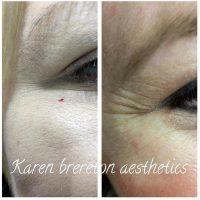
Botox Treatment Areas On The Face
Other than for wrinkles other cosmetic uses are to open the eyes, lengthen the face and to address bands on the neck. (Dina D. Strachan, MD, New York Dermatologist)
Entire face wrinkled–Botox may not be the best answer.
Since Botox and Dysport work to paralyze muscles of expression, you can’t use Botox where you still want to have the ability to animate your face. Do you need to frown? Probably not, so this is the most common area of use, and the first area that Botox was FDA approved for use.
Crows feet around your eyes–you still need to be able to blink, so thee can be reduced, but not completely eliminated. And so on. But if your entire face is wrinkled, you may need additional considerations.
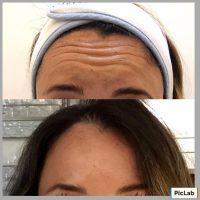
How Much Botox Should You Use
Depending on the overall skin tone and your age, you may be a candidate for facelift, eyelid surgery, and/or browlift (forehead lift).
Then, when everything is healed, the lines around your mouth and all other areas where wrinkles and lines remain can be treated by laser resurfacing or chemical peel to rejuvenate the surface of the skin. (Doing this before cosmetic surgery is the wrong order–you would end up with “smooth jowls” and then still need a facelift!)
Consider a consultation with a board-certified plastic surgeon (American Board of Plastic Surgery) who has the comprehensive training and skill to evaluate your entire situation and recommend what is best, not just what someone does.
Everyone seems to want the “non-surgical” facelift or get more than they pay for (the “lunchtime lift”, the Thread lift, etc.) Beware marketing hype and get the facts first! (Richard H. Tholen, MD, FACS, Minneapolis Plastic Surgeon)
Botox is designed to treat those wrinkles that are related to muscle movement as the botox works by relaxing the muscle. It will not help those lines that are from deep sundamage such as the mid cheek.
Treatment of lines on the lower cheek near the mouth or lip could cause unwanted side effects such as problems smiling, eating and speaking. Botox is commonly and safely done on the forehead horizontal lines, glabellar creases between the eyebrows, and when carefully done can help lift the jowl over the jaw, minimimze the pursing vertical creases of the upper lip and elevate the corners of the lips when they are hanging down by injecting the DAO (depressor anguli oris) muscle.
It can help smoothen the dimpling in the chin and help flatten vertical muscle banding of the neck.
Most of the latter indications are off-label uses and should be done by an expert so as to lessen the chance of affecting unwanted muscle groups. (Ronald Shelton, MD, Manhattan Dermatologic Surgeon)
Botox or Dysport does not work for every facial wrinkle
As a facial plastic surgeon I evaluate eveyone’s face individually and discuss what option are available. Sometimes that includes Botox/Dysport, sometimes that includes surgery or several other treatments. I perform about 35-50 facelifts each month and am in the top 1% in the country for Botox so I have a vast experience in both surgical and non-surgical treatments.
I think it is important to go to a doctor who has extensive experience in BOTH areas so that you can get the most well- rounded experience and recommendations! (Robert F. Gray, MD, FACS, Bay Area Facial Plastic Surgeon)
Botox For Wrinkles
Botox is a safe and affordable treatment for fine wrinkles when given by board certified physician. The areas that are most commonly treated to reduce fine wrinkles include the lines between the eyebrows, the forehead, and the crows feet on the sides of the eyes.
Other commonly treated areas include the “bunny lines” on the sides of the nose, lip lines above and below the lips, the chin for people who dimple their chins, neck bands, and the DAO muscle below the lip to soften downward-turned lips. (Hooman Khorasani, MD, New York Dermatologic Surgeon)
I often get the question what is the difference between Botox and fillers. Botox is great for reducing frown lines associated with facial expressions. Good examples are the forehead lines when you raise your browns, the frown lines between the Brows when you’re giving a stern look, or the smile lines along the sides of the Eyes when you are smiling.
Fillers on the other hand are great for softening any shadows or lines or folds in the face when you’re not making any facial expression. (Young R. Cho, MD, PhD, Houston Plastic Surgeon)
